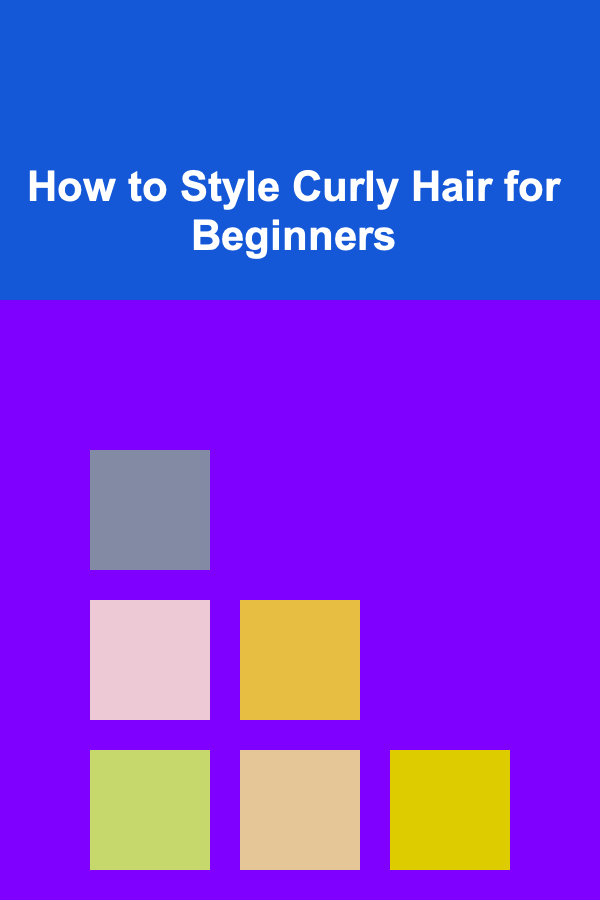
How to Style Curly Hair for Beginners
ebook include PDF & Audio bundle (Micro Guide)
$12.99$8.99
Limited Time Offer! Order within the next:

Curly hair can be a blessing or a challenge, depending on how it's managed. While it holds a unique beauty with its volume and texture, styling it often requires special techniques and products to maintain its natural beauty. If you're new to curly hair care, the learning curve can feel steep, but with the right guidance, you can enhance your curls and rock them confidently. This article provides an in-depth guide on how to style curly hair for beginners, offering useful tips, techniques, and advice on how to care for your curls.
Understanding Curly Hair
Curly hair is different from straight or wavy hair because of its natural texture. The hair follicles are oval or asymmetrical, which causes the hair to bend and form curls or waves. The curl pattern can vary from loose waves to tight coils, and each curl type requires different care. The key to managing curly hair is understanding its needs, as curly hair tends to be drier than straight hair. This is because the natural oils have a harder time traveling down the twists and turns of each strand.
Curly Hair Types
Curly hair comes in different types and each type requires different styling techniques:
- Type 1: Straight hair with no curl.
- Type 2: Wavy hair with a loose S-shape, which can be prone to frizz.
- Type 3: Curly hair with a defined curl pattern, ranging from loose curls to tight coils.
- Type 4: Kinky or coily hair with tightly packed curls, often fragile and more prone to dryness.
Understanding your curl type is essential in choosing the right products and techniques for styling.
Steps to Style Curly Hair for Beginners
1. Proper Hair Care Routine
Before diving into styling techniques, you must establish a strong hair care routine. Curly hair tends to be drier, so you need to keep it hydrated and nourished. A solid curly hair routine includes the following:
- Cleansing: Use a sulfate-free shampoo to avoid stripping natural oils from your hair. Opt for moisturizing or hydrating shampoos, as they help maintain your curls' softness.
- Conditioning: Apply a good conditioner to keep your curls hydrated. Conditioners with added oils like argan or jojoba are perfect for curly hair because they provide moisture and shine.
- Deep Conditioning: Once a week, treat your curls to a deep conditioning treatment. This helps nourish and repair any damage, leaving your curls softer and more manageable.
- Detangling: Detangle your curls while they're still wet and conditioned using a wide-tooth comb or your fingers. This minimizes breakage and frizz.
2. The Right Products for Curly Hair
Finding the right products for curly hair is a game-changer. Here's what you should be looking for:
- Leave-In Conditioners: These help moisturize and detangle hair. Leave-in conditioners provide the foundation for styling by making curls more defined.
- Curl Creams or Gels: These products are designed to hold your curls in place without making them crunchy. They enhance curl definition and control frizz. Gel can also be used to lock in moisture.
- Oils and Serums: Use oils like argan oil, castor oil, or coconut oil to add shine and reduce frizz. Oils are great for sealing in moisture and preventing hair from looking dry.
- Hair Mousse: Mousse can give your curls volume and texture without weighing them down. It's a lightweight option for curly hair.
3. Techniques for Styling Curly Hair
Now that you have a solid foundation with the right products, it's time to explore styling techniques that will enhance your curls.
A. The "Curly Girl" Method
The "Curly Girl" method is a popular styling technique that involves avoiding harsh ingredients like sulfates, silicones, and alcohol, and focusing on moisturizing products. Here's a basic breakdown:
- Co-Washing: Co-washing is short for conditioner washing, where you use a conditioner to cleanse your hair rather than shampoo. It prevents your curls from becoming too dry.
- Plopping: This is a technique where you wrap your wet curls in a cotton t-shirt or microfiber towel. It absorbs excess water while enhancing your curl shape.
- Scrunching: After applying a curl cream or gel, scrunch your hair upwards towards your scalp to encourage curl formation. This helps define each curl.
B. The "Praying Hands" Technique
For curl definition and clump-free curls, use the "praying hands" method. Here's how to do it:
- Take a generous amount of curl cream or gel in your hands.
- Apply the product evenly through your curls by gliding your hands from the roots to the tips in a smooth, praying hands motion. This method helps distribute the product without disrupting the curl pattern.
C. Diffusing
A diffuser is a blow-drying attachment designed for curly hair. It helps dry curls without causing frizz, adding volume and definition to the hair.
- Set your blow dryer to a low or medium heat setting. High heat can cause frizz.
- Flip your head upside down or use the diffuser to lift your curls from the roots. This technique adds volume and minimizes frizz.
- Dry your curls completely, or allow them to air dry after diffusing.
D. Finger Coiling
For very defined curls, finger coiling is a great option. To finger coil, take a small section of hair, apply some styling gel or cream, and wrap the hair around your finger to form a perfect curl. This technique is time-consuming but yields beautiful results for tightly defined curls.
4. Dealing with Frizz
Frizz is one of the most common challenges when styling curly hair. To minimize frizz, follow these tips:
- Avoid Touching Your Curls: After applying products, try not to touch your hair as it dries. Touching it causes frizz and disrupts the curl formation.
- Use a Microfiber Towel: Regular towels can rough up the hair cuticle, causing frizz. Instead, use a microfiber towel or an old cotton t-shirt to gently blot your curls.
- Don't Over-Dry: Over-drying your curls can cause them to become frizzy. Always leave your curls slightly damp for a more natural finish.
5. Protecting Your Curls While Sleeping
Curls are more prone to tangling and frizz while you sleep. To protect your curls at night:
- Pineapple Method: This involves loosely gathering your curls on top of your head and securing them with a silk or satin scrunchie. This prevents flattening and helps maintain curl shape overnight.
- Silk or Satin Pillowcase: Swap out your cotton pillowcase for a silk or satin one to minimize friction and frizz.
- Satin Bonnet: Wearing a satin bonnet can also help protect curls while you sleep.
6. Regular Haircuts and Trims
Curly hair is prone to split ends and can lose its shape over time. To maintain healthy curls, make sure to get regular trims. You may also want to explore a curly cut, which is specially tailored to enhance your natural curl pattern.
Troubleshooting Common Curly Hair Problems
Even with a solid routine, curly hair can present unique challenges. Here are solutions to common problems:
- Flat or Limp Curls: If your curls look lifeless, you may need a volumizing product or a stronger hold gel. A diffuser can also help add volume.
- Dry Curls: If your curls are dry, add a richer moisturizing conditioner to your routine or incorporate a deep conditioning mask once a week.
- Uneven Curls: To even out curls, you may need a curly cut that considers your curl pattern. Using curl creams or gels can also help smooth out uneven texture.
Conclusion
Styling curly hair can seem like a complicated task at first, but with the right understanding, products, and techniques, you can learn to manage and enhance your natural curls. Building a proper hair care routine and utilizing the best styling methods for your curl type will allow you to achieve soft, bouncy, and beautiful curls every day. Embrace your curls with confidence, and experiment with different techniques to discover what works best for you.
Reading More From Our Other Websites
- [Skydiving Tip 101] How to Build a DIY Skydiving Logbook That Meets USPA Certification Standards
- [Home Holiday Decoration 101] How to Organize Holiday Decorations to Avoid Clutter
- [Hiking with Kids Tip 101] Family-Friendly Trails for Hiking with Babies in a Carrier
- [Tiny Home Living Tip 101] Best Minimalist Kitchen Designs for Tiny Home Living on a Shoestring Budget
- [Organization Tip 101] Must-Have Decor Pieces for Your Boho Bedroom Makeover
- [Home Holiday Decoration 101] How to Decorate a New Home for the Holidays with a Fresh Look
- [Organization Tip 101] How to Create a Sustainable Home Organization Strategy
- [Organization Tip 101] How to Create a Music Mood Board for Inspiration
- [Personal Finance Management 101] How to Break the Cycle of Living Paycheck to Paycheck
- [Home Maintenance 101] How to Care for Your Home's Carpets to Keep Them Clean and Fresh

How to Declutter Your Home for a Fresh Start
Read More
How to Understand the Psychology of Risk-Taking in Extreme Sports
Read More
How To Master Dice Rolling in Board Games
Read More
How to Build a Debt Repayment Checklist for Single Parents
Read More
How to Plan Your Social Life in Retirement: A To-Do List
Read More
10 Tips for Maximizing Investment Interest Expense Deductions
Read MoreOther Products

How to Declutter Your Home for a Fresh Start
Read More
How to Understand the Psychology of Risk-Taking in Extreme Sports
Read More
How To Master Dice Rolling in Board Games
Read More
How to Build a Debt Repayment Checklist for Single Parents
Read More
How to Plan Your Social Life in Retirement: A To-Do List
Read More